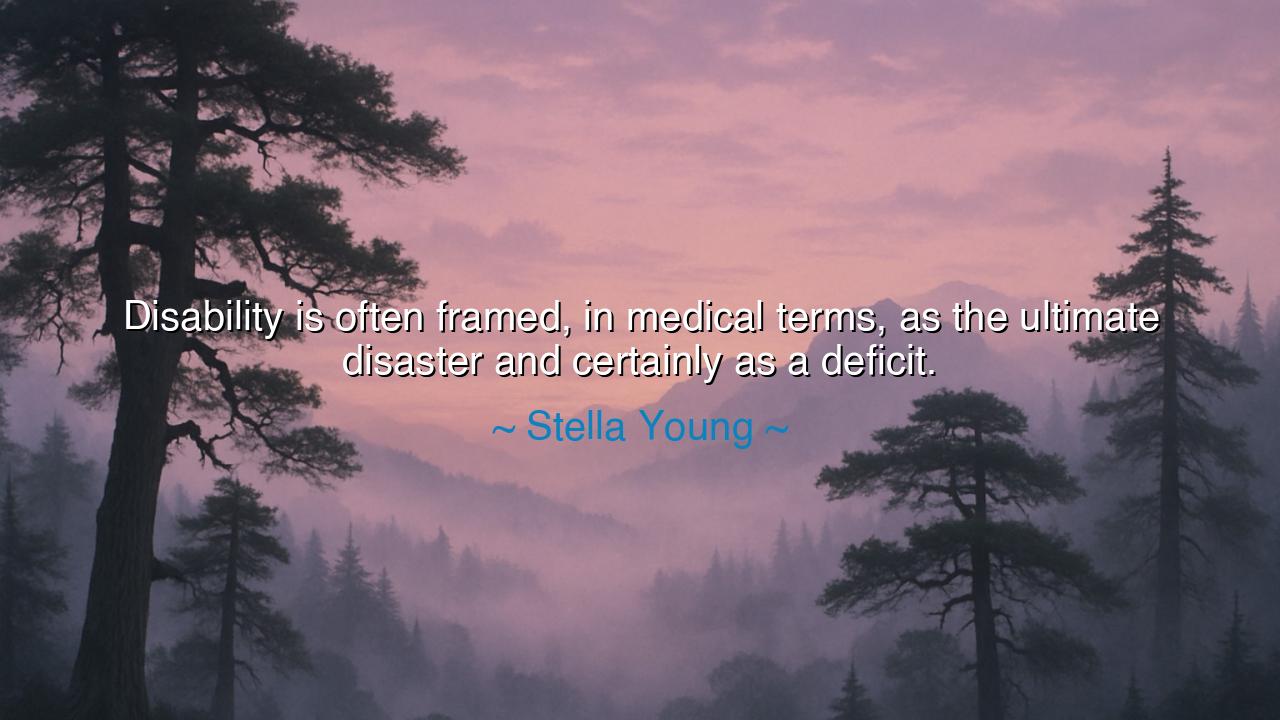
Disability is often framed, in medical terms, as the ultimate
Disability is often framed, in medical terms, as the ultimate disaster and certainly as a deficit.






“Disability is often framed, in medical terms, as the ultimate disaster and certainly as a deficit.” Thus spoke Stella Young, a voice both fierce and compassionate, who challenged the blindness of a world that claimed to see. In these words lies a truth that cuts through centuries of misunderstanding — that disability, though often defined by the body’s limits, is not the ruin of the human spirit, but a different expression of its resilience. Young, born with osteogenesis imperfecta — a condition that made her bones fragile but her mind unbreakable — saw through the narrow lens of pity that society used to view her. She understood that the real deficit was not in the body, but in perception — in the smallness of vision that equates difference with tragedy.
When she spoke of the medical framing, she revealed a profound imbalance in how humanity has long measured worth. For medicine, noble though it is, often views life through the lens of what is broken — what can be cured, repaired, or fixed. It sees the human form as a mechanism, and when the mechanism falters, it names it “deficit.” But Young reminds us that the human being is not a machine; it is a soul wrapped in experience. To call disability a disaster is to forget that every human being is, in some way, incomplete — and that it is from that incompleteness that compassion, creativity, and courage are born. The error of the world lies not in acknowledging struggle, but in mistaking struggle for failure.
In the ancient days, those born different were often cast aside — deemed cursed by gods, or unfit for life’s trials. Yet even then, there were whispers of deeper wisdom. The philosophers of old, who prized beauty and form, also taught that virtue, not appearance, is the measure of man. Consider the story of Epictetus, the great Stoic philosopher, who was born a slave and later crippled by his master. When his leg was twisted and broken, he merely said, “You will break it,” and when it snapped, he said, “Did I not tell you so?” Yet from that broken body came some of the most enduring teachings on peace, strength, and self-mastery. His spirit, like Stella Young’s, defied the notion that a damaged form means a damaged life.
Stella Young, in her age, carried that same torch — not through marble temples or royal courts, but through her words, her laughter, and her defiance. She refused the role that society had written for her — that of the “inspirational cripple,” the object of pity who teaches others gratitude by her mere survival. “I am not your inspiration,” she declared, challenging a culture that romanticized her difference instead of respecting her equality. She taught that disability is not a tragedy to be pitied, but a reality to be understood — that the true tragedy lies in a world built without room for every kind of body, every kind of life. Her fight was not against her condition, but against the illusion that it made her lesser.
When she said that disability is “framed as a deficit,” she pointed to the failure not of flesh, but of imagination. For in truth, every society defines ability according to its own structures — its stairs, its tools, its expectations. To one culture, walking is natural; to another, riding is noble. To one mind, a wheelchair is limitation; to another, it is liberation. Thus, the so-called deficit exists only in relation to systems that refuse to adapt. The wise see that the problem is not the person, but the structure; not the body, but the blindness of those who refuse to make room for all bodies.
Consider the story of Helen Keller, born into darkness and silence. To the doctors of her time, she was “hopeless,” a child locked in her own body. Yet through the devotion of her teacher, Anne Sullivan, she awakened to language, thought, and purpose. She became not merely a survivor, but a philosopher, an activist, a voice for millions. Her life proved what Stella Young declared in her own time — that the true disaster is not disability itself, but the ignorance that confines it. Keller’s world expanded not because her body was cured, but because her society learned, through her, to listen differently.
So, my children, learn this sacred truth: disability is not the absence of wholeness, but another form of it. Every human being bears limitations — some seen, some unseen — and it is through them that we learn patience, empathy, and resilience. Do not pity those whose paths are harder; walk beside them, and let their strength become your lesson. Do not see the disabled as broken; see them as teachers of adaptation, masters of endurance, and mirrors of your own humanity.
And let us remember Stella Young’s wisdom as both challenge and promise: to change how we see is to change what is possible. Build a world not of pity, but of inclusion. Speak of disability not as a curse, but as a reality woven into the human story. And when you meet someone who lives differently, bow your heart — for they walk not behind you, but beside you, as equals in the shared and sacred labor of being human.






AAdministratorAdministrator
Welcome, honored guests. Please leave a comment, we will respond soon